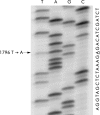BRAF mutation is associated with DNA methylation in serrated polyps and cancers of the colorectum
- PMID: 15247181
- PMCID: PMC1774130
- DOI: 10.1136/gut.2003.037671
BRAF mutation is associated with DNA methylation in serrated polyps and cancers of the colorectum
Abstract
Background and aims: Mutations in BRAF have been linked with colorectal cancers (CRC) showing high level microsatellite instability (MSI-H). However, the distribution of BRAF mutations in MSI-H cancers remains to be clarified with respect to precursor lesions and the CpG island methylator phenotype (CIMP).
Methods: Forty three hyperplastic polyps (HP), nine mixed polyps (MP), five serrated adenomas (SA), 28 conventional adenomas (AD), 18 hereditary non-polyposis colorectal cancers (HNPCC), and 127 sporadic CRC (46 MSI-H and 81 non-MSI-H) were collected from patients undergoing colectomy for either CRC or hyperplastic polyposis. Twenty five of 57 serrated lesions were derived from four patients with hyperplastic polyposis. HP were further subdivided according to recently documented morphological criteria into 27 classical HP and 16 variant lesions described as "sessile serrated adenoma" (SSA). All tumours were screened for BRAF activating mutations.
Results: The BRAF mutation was more frequent in SSA (75%) and MP (89%) than in classical HP (19%), SA (20%), and AD (0%) (p<0.0001), and also in sporadic MSI-H cancers (76%) compared with HNPCC (0%) and sporadic non-MSI-H cancers (9%) (p<0.0001). The BRAF mutation was identified more often in CIMP-high serrated polyps (72%) and CIMP-high CRC (77%) than in CIMP-low (30%) and CIMP-negative (13%) polyps (p = 0.002) as well as CIMP-low (18%) and CIMP-negative (0%) CRC (p<0.0001).
Conclusions: The BRAF mutation was frequently seen in SSA and in sporadic MSI-H CRC, both of which were associated with DNA methylation. Sporadic MSI-H cancers may originate in SSA and not adenomas, and BRAF mutation and DNA methylation are early events in this "serrated" pathway.
Figures



Similar articles
-
Comparison of microsatellite instability, CpG island methylation phenotype, BRAF and KRAS status in serrated polyps and traditional adenomas indicates separate pathways to distinct colorectal carcinoma end points.Am J Surg Pathol. 2006 Dec;30(12):1491-501. doi: 10.1097/01.pas.0000213313.36306.85. Am J Surg Pathol. 2006. PMID: 17122504
-
The serrated neoplasia pathway of colorectal tumors: Identification of MUC5AC hypomethylation as an early marker of polyps with malignant potential.Int J Cancer. 2016 Mar 15;138(6):1472-81. doi: 10.1002/ijc.29891. Epub 2015 Oct 30. Int J Cancer. 2016. PMID: 26476272
-
MicroRNA-31 expression in relation to BRAF mutation, CpG island methylation and colorectal continuum in serrated lesions.Int J Cancer. 2014 Dec 1;135(11):2507-15. doi: 10.1002/ijc.28920. Epub 2014 Apr 30. Int J Cancer. 2014. PMID: 24752710
-
Colorectal serrated adenocarcinoma.Histopathology. 2007 Jan;50(1):131-50. doi: 10.1111/j.1365-2559.2006.02548.x. Histopathology. 2007. PMID: 17204027 Review.
-
The case for a genetic predisposition to serrated neoplasia in the colorectum: hypothesis and review of the literature.Cancer Epidemiol Biomarkers Prev. 2006 Oct;15(10):1778-84. doi: 10.1158/1055-9965.EPI-06-0164. Cancer Epidemiol Biomarkers Prev. 2006. PMID: 17035382 Review.
Cited by
-
Serrated polyps of the large intestine: current understanding of diagnosis, pathogenesis, and clinical management.J Gastroenterol. 2013 Mar;48(3):287-302. doi: 10.1007/s00535-012-0720-y. Epub 2012 Dec 4. J Gastroenterol. 2013. PMID: 23208018 Free PMC article. Review.
-
Lynch syndrome diagnostics: decision-making process for germ-line testing.Clin Transl Oncol. 2012 Apr;14(4):254-62. doi: 10.1007/s12094-012-0793-3. Clin Transl Oncol. 2012. PMID: 22484632 Review.
-
Serrated polyps and the risk of synchronous colorectal advanced neoplasia: a systematic review and meta-analysis.Am J Gastroenterol. 2015 Apr;110(4):501-9; quiz 510. doi: 10.1038/ajg.2015.49. Epub 2015 Mar 10. Am J Gastroenterol. 2015. PMID: 25756237 Review.
-
Differences in epidemiologic risk factors for colorectal adenomas and serrated polyps by lesion severity and anatomical site.Am J Epidemiol. 2013 Apr 1;177(7):625-37. doi: 10.1093/aje/kws282. Epub 2013 Mar 3. Am J Epidemiol. 2013. PMID: 23459948 Free PMC article.
-
Association of the colorectal CpG island methylator phenotype with molecular features, risk factors, and family history.Cancer Epidemiol Biomarkers Prev. 2015 Mar;24(3):512-519. doi: 10.1158/1055-9965.EPI-14-1161. Epub 2015 Jan 13. Cancer Epidemiol Biomarkers Prev. 2015. PMID: 25587051 Free PMC article.
References
-
- Kinzler KW, Vogelstein B. Lessons from hereditary colorectal cancer. Cell 1996;87:159–70. - PubMed
-
- Jass JR, Whitehall VL, Young J, et al. Emerging concepts in colorectal neoplasia. Gastroenterology 2002;123:862–76. - PubMed
-
- Vogelstein B , Fearon ER, Hamilton SR, et al. Genetic alterations during colorectal-tumor development. N Engl J Med 1988;319:525–32. - PubMed
-
- Hawkins NJ, Ward RL. Sporadic colorectal cancers with microsatellite instability and their possible origin in hyperplastic polyps and serrated adenomas. J Natl Cancer Inst 2001;93:1307–13. - PubMed
Publication types
MeSH terms
Substances
Grants and funding
LinkOut - more resources
Full Text Sources
Other Literature Sources
Medical
Research Materials
Miscellaneous
